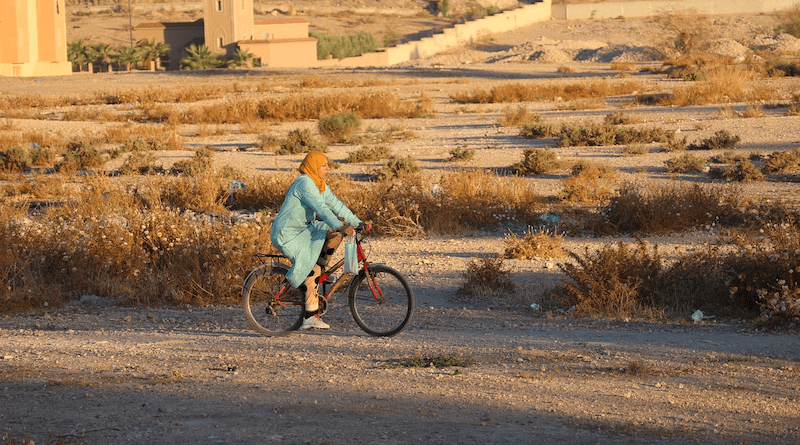Climate And Agricultural Disruption: The Need For Participatory Methods And Inclusion Of Women – OpEd
Change in weather patterns and environmental behavior is one of the biggest threats to the world today. Human activity perpetuates this through deforestation, transportation, powering buildings, and more. The effects yet take a toll on people, ranging from displacement to droughts to lack of food.
These patterns highlight an overlooked piece of the puzzle: they are not only the ones most impacted by disruptions to local climate, but also the main drivers of the change. In other words, human behavior, engagement, and attitude towards the environment is crucial. This dynamic highlights the need for social dimensions and participatory actions to be incorporated into effective, sustainable solutions.
Facilitating these actions are specifically necessary for rural villages in Morocco. Morocco’s rural and mountainous regions are extremely vulnerable to environmental disasters and its long-term effects. This is due to its reliance on agricultural production and animal husbandry as well as its geographic location. Being in the heart of the vulnerable land, the people have extensive knowledge of the land and employ long-held traditions to treat and interact with the topography. With this close relationship between human and environment, there’s a greater stress on the dynamics of humans being the perpetrators and victims of disruptions to climate patterns.
One of the dilemmas of community and participatory building with climate dialogue is the exclusion of women in capacity building. Studies show that more stringent climate policies were adapted with the inclusion of both men and women in community dialogue. Furthermore, “the participation of women in natural resource management is associated with better resource governance and conservation outcomes” at the local level.
Amina El Hajjami, a project manager at High Atlas Foundation, has worked closely and lived in the mountain regions in Morocco. She remarks how women have the biggest power to fight this despite being the most affected by it because of their knowledge and frequent interaction of their land. In local settings, women have been seen to have better knowledge of the land and climate; historically women have an extensive knowledge of the land and agricultural methods, such as harvesting, natural resource management, and agricultural preservation. Some of this knowledge is also passed down by tradition – another important reason why women need to be included in these agricultural community efforts.
Since men traditionally possess the land, women often have little say or participation in community dialogue. Women are also the most impacted by disruptions to agriculture and climate patterns. Women tend to take up many agricultural job roles. With increased periods of drought or unusual climate patterns, it affects agricultural productivity, making harvesting and collecting take a longer time as well as produce low income and resources for one’s family. As a result, this affects a female’s ability to tend to other things, such as attend school or access relief and assistance due to the prolonged time and limited income.
There are several approaches and considerations to alleviate this dynamic between gender inequality and climate troubles. One is to understand and view the situation from a social lens in dialogue and conversations through participatory methods. Better knowledge and engagement of their land and climate they are dealing with will make them able to sustain natural land better. Governments are involved in the process, but the focus points aren’t typically aligned with what the community prioritizes as an issue. Participatory methods allow prioritizing community needs and interpreting land as they see it. However, this approach requires facilitation and community engagement and planning, further calling for the inclusion of women in the conversation.
One study focused on using participatory methods to increase female participation in environmental efforts as well as their importance in Northern Ghana. Similar to Morocco, agricultural practices play an important role in villages and communities, yet they are vulnerable to environmental disasters. Local knowledge is a crucial resource, especially from women, to manage and combat changes to land and climate patterns. Several participatory methods were used involving women in agriculture and land practices. These included deciding villager priorities, facilitated knowledge exchange, and auto-appraisal methods.
The auto-appraisal method is a “structured assessment of local conditions, needs and opportunities conducted by local people”, and it’s a chance for community members to develop solutions together. Participatory efforts through empowerment and local dialogue gave women greater confidence and chances to demonstrate their knowledge. Because women bore a share of the effects from the environmental destruction, the participatory inclusion let them express this and how it may be dealt with. This resulted in greater consensus in action between women and men and commitment to environmental change and agricultural conservation.
The three participatory methods proved to be effective and can be adapted in Morocco, too. The High Atlas Foundation has been on the front of initiating participatory efforts towards combating environmental and agricultural issues, as well as empowering women in the efforts. The hope is to implement solutions that are real and effective for the communities affected. Participatory methods address local priorities and the inclusion of women in the dialogue, and should be continued to do so for a sustainable future.

